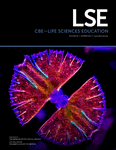Effectiveness and Adoption of a Drawing-to-Learn Study Tool for Recall and Problem Solving: Minute Sketches with Folded Lists
Abstract
Drawing by learners can be an effective way to develop memory and generate visual models for higher-order skills in biology, but students are often reluctant to adopt drawing as a study method. We designed a nonclassroom intervention that instructed introductory biology college students in a drawing method, minute sketches in folded lists (MSFL), and allowed them to self-assess their recall and problem solving, first in a simple recall task involving non-European alphabets and later using unfamiliar biology content. In two preliminary ex situ experiments, students had greater recall on the simple learning task, non-European alphabets with associated phonetic sounds, using MSFL in comparison with a preferred method, visual review (VR). In the intervention, students studying using MSFL and VR had ∼50–80% greater recall of content studied with MSFL and, in a subset of trials, better performance on problem-solving tasks on biology content. Eight months after beginning the intervention, participants had shifted self-reported use of drawing from 2% to 20% of study time. For a small subset of participants, MSFL had become a preferred study method, and 70% of participants reported continued use of MSFL. This brief, low-cost intervention resulted in enduring changes in study behavior.



